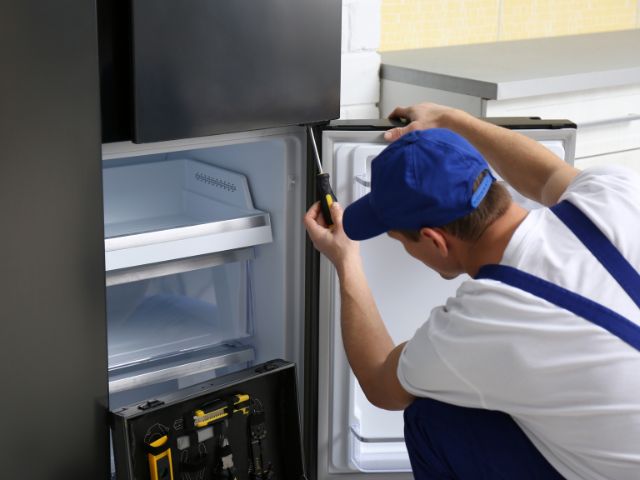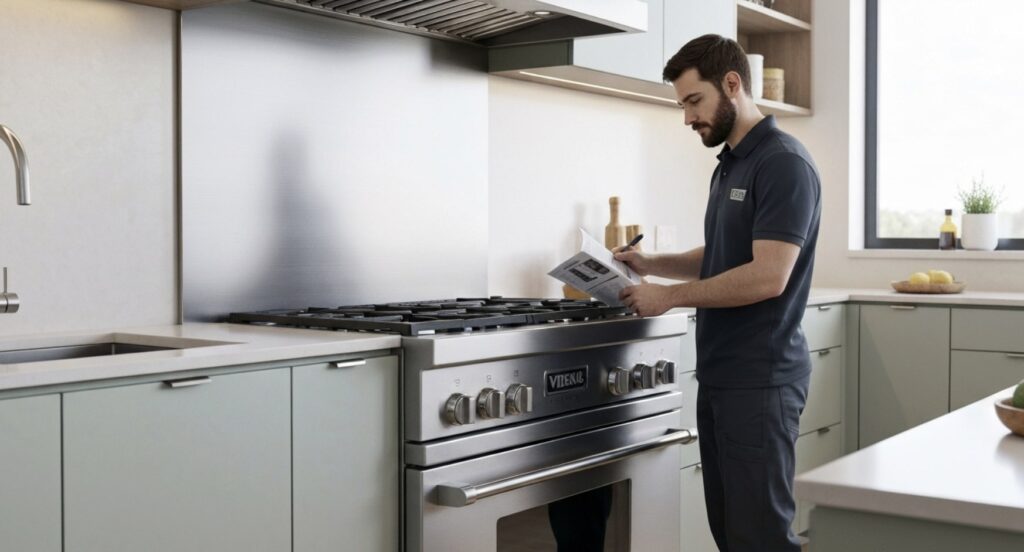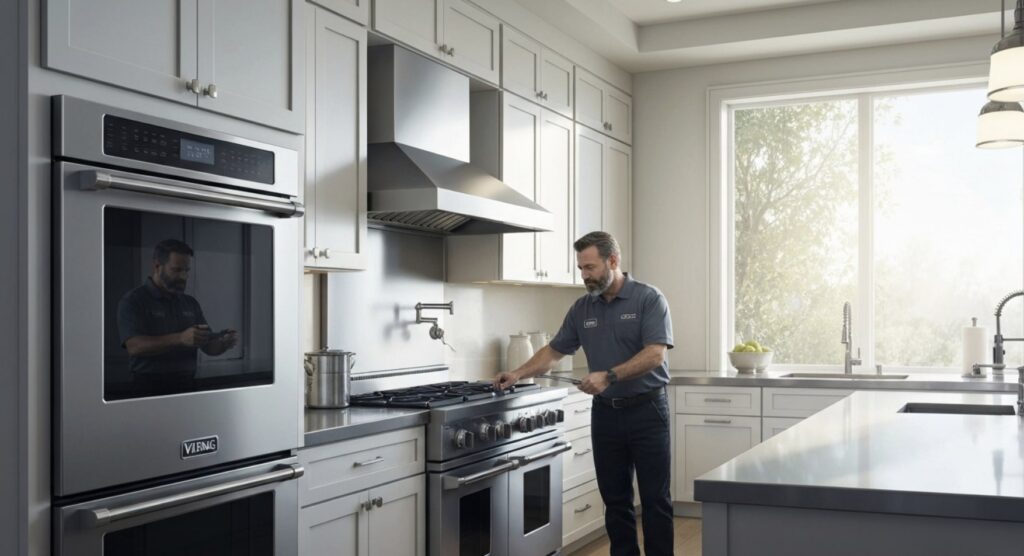Frost buildup in your freezer is a usual issue. It can make the freezer less efficient and affect the quality of your frozen food. This happens when warm, moist air gets into the freezer. When this air touches the cold surfaces, it freezes. Keeping the right freezer temperature is important. However, other things besides temperature can also cause frost build-up. Let’s look at what causes frost buildup in freezers. We will also find ways to keep your appliance running well and frost-free.
Understanding Frost Buildup in Freezers
A small amount of frost in your Viking freezer is normal. But too much frost means there is a problem that you need to fix. This often happens when warm air enters your freezer. This air causes condensation that then freezes.
Knowing what causes frost buildup can help you take steps to prevent it. This will keep your freezer running well. It will also help keep your frozen food in good shape. This helps avoid freezer burn and bad smells.
The Science Behind Frost Formation
Frost forms in a simple way. When warm, moist air touches a surface that is very cold, the water vapor in the air turns into liquid water.
Since the surface is below freezing, the water changes again and becomes solid. This creates ice crystals, which we see as frost.
In your freezer, changes in temperature cause issues, especially when you open the door often or if the door isn’t sealed well. These changes make water condense and freeze again and again. This cycle leads to a buildup of frost on the inside of the freezer, especially on the cooling coils.
Common Mistakes Leading to Frost Issues
One big reason for freezer frost is leaving the door open for too long or opening it a lot. When you open the door, warm air comes in. This warm air cools down and makes condensation. That can cause frost to form.
Another mistake is overpacking the freezer. If you fill it up too much, you block the airflow. This can make it hard for the freezer to keep a steady temperature. Warmer areas can form, which can lead to more frost.
Also, putting uncovered or loosely sealed containers in the freezer makes frost worse. Moisture from the food or liquids can escape into the air. This extra moisture adds humidity, making frost form faster.
Identifying the Culprits of Frost Buildup
Excessive frost in your freezer can come from more than just how you use it. There are also several mechanical issues to consider. These issues often relate to parts that keep your freezer cold and prevent air from getting in.
Door Seal Leaks and Their Impact on Freezer Efficiency
A damaged or worn-out door seal is a frequent culprit behind persistent frost buildup. A properly functioning door seal is crucial for maintaining the freezer’s cold temperature and preventing warm air from seeping in.
Over time, these seals can become worn, cracked, or lose their flexibility, creating gaps that compromise the freezer’s efficiency. This allows warm, humid air to infiltrate, leading to increased condensation and frost formation.
Here are a few signs of a leaking door seal:
| Sign | Description |
| Visible frost around the door | You’ll notice ice crystals concentrated around the edges of the door. |
| Door doesn’t close properly | The door might not shut tightly or require extra force to close. |
| Condensation on the door | You might see water droplets on the door’s surface, indicating a temperature difference. |
Incorrect Temperature Settings and Overloading
One common mistake that can lead to a very cold freezer is setting the freezer temperature too high. The best temperature for a freezer is 0°F (-18°C) or lower. If it is set higher, the freezer may have a hard time keeping everything frozen, which can create frost.
Also, putting too much in your freezer can block air circulation. This makes it hard for the cold air to move around evenly. When cold air can’t flow, it can cause temperature changes and lead to more frost. Keeping space around frozen items is important for good air flow.
Make sure to check your freezer’s temperature regularly to keep it at the right level, and do not set it warmer than needed. Try not to overload your freezer so air can flow freely.
Practical Steps to Prevent Frost
Preventing frost from building up is important. It requires good habits and regular care for your freezer. If you follow these steps, your freezer will work better. You will also not need to defrost it as often.
Some simple actions can help a lot. Do not leave the freezer door open for a long time. Cool your food to room temperature before freezing it. Also, arrange things in the freezer so that air can flow well.
The Right Way to Arrange Food in Your Freezer
Proper food arrangement in your freezer is very important. It helps reduce frost buildup and keeps your freezer working well. If you just pile things in, the air can’t move. This leads to uneven temperatures and more frost.
Here are some tips to avoid these problems:
- Leave space between items: Make sure there is enough space between food containers. This helps air flow properly.
- Don’t stack items too high: Try not to make tall stacks of food. This can stop air from reaching the top of the freezer.
- Use freezer-safe containers: Choose containers made for storing in the freezer. They should be airtight, so they prevent freezer burn and keep moisture out.
Essential Maintenance Tips for Frost-Free Operation
Regular maintenance is important to keep your freezer working well and to prevent frost buildup. A key step is to defrost your freezer every now and then. Do this, especially if you see a lot of frost.
You should also check your freezer’s door gaskets often. These gaskets help keep air from getting in, which is very important. If you find any cracks, tears, or wear, replace them right away.
Lastly, make sure your freezer is clean. Crumbs, spills, and food bits can affect how the door seals and can cause germs to grow. Clean the inside regularly with a mix of baking soda and water.
Conclusion
Frost buildup happens often. However, knowing what causes frost buildup in freezers and how to prevent it can really help. Fixing things like leaks in the door seal and setting the right temperature can keep your freezer working well. Keeping food organized and doing regular maintenance is also important for avoiding frost. If you want to learn more insights, visit our blog about Debunking Common Holiday Viking Freezer Repair Myths. Stay informed and keep your freezer in great shape!
Frequently Asked Questions
Is frequent freezer door opening a factor contributing to frost formation?
Frequent opening of the freezer door causes a lot of frost. When you open the door, warm and humid air comes in. This change makes the temperature go up and down. As a result, condensation happens, and frost builds up on the inside surfaces of the freezer appliance.
Does the age and condition of the freezer affect the likelihood of frost buildup?
An older freezer that is not well cared for can easily fill with frost. As appliances get older, parts like door seals and thermostats can wear out. This makes it easier for warm air to get inside, which can cause temperature fluctuations.
How can the placement of food items affect frost buildup in a freezer?
Improper food placement in the freezer can cause problems. If the freezer is overcrowded or if air vents are blocked, cold air cannot circulate well. This may result in uneven temperatures inside the freezer. When this happens, warm spots can appear, which makes condensation and frost more likely to form.






